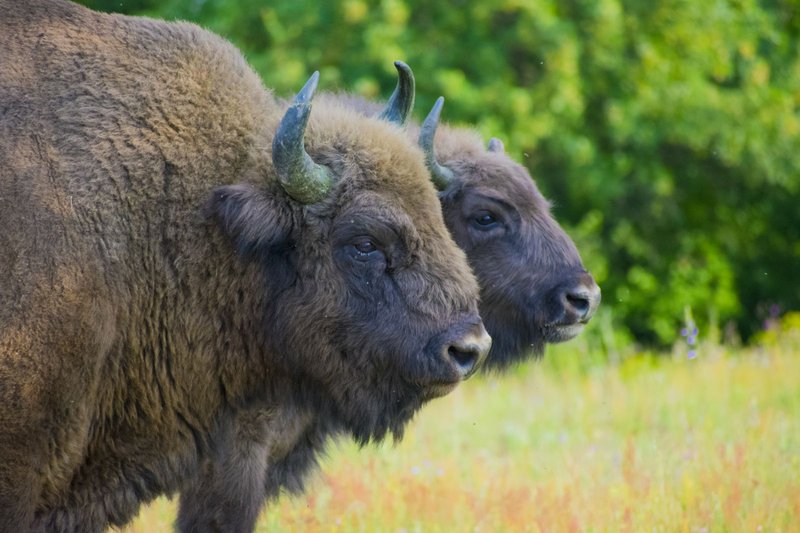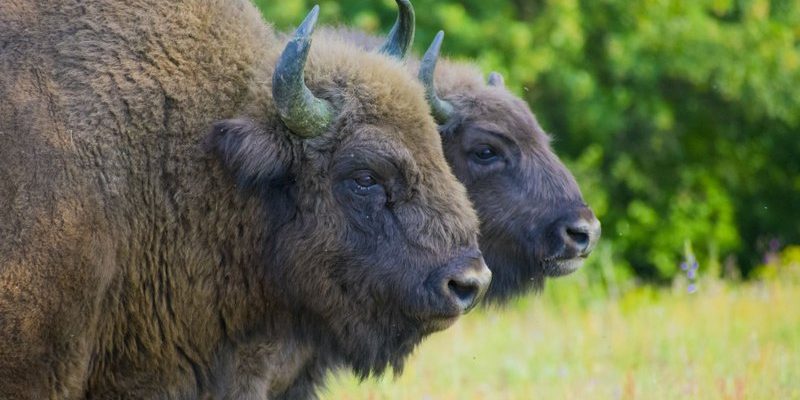
When you think of the European bison, you might picture a huge, shaggy animal lumbering through the woods, but there’s so much more to their story. Just like how humans wear warm clothing to protect themselves from the cold, these bisons have developed unique traits and behaviors that help them endure tough conditions. Let me take you on a journey through their world and explain how these magnificent creatures manage to do so.
The European Bison’s Habitat
To understand how European bisons survive, we first need to explore their habitat. European bisons primarily live in forested areas, grasslands, and even some mountainous regions across Europe. Surprisingly, they have a remarkable ability to adapt to various environments.
While they tend to prefer dense woodlands, you might find them grazing in open fields or roaming through scrublands. This diversity in habitat helps them find food and shelter year-round. They often travel in herds, which provides additional protection from predators and harsh weather. Here’s the thing: by sticking together, they can more easily detect danger and find resources.
– Woodlands: Dense forests provide cover and warmth during winter.
– Grasslands: Open spaces are great for grazing when food is scarce in the woods.
– Mountains: Higher altitudes offer a safe retreat from predators and other threats.
By moving through these varied habitats, European bisons can react to changing conditions, like food shortages or severe weather, making them adaptable survivors.
Physical Adaptations for Survival
European bisons are built to handle harsh environments, and their physical features reflect this adaptability. Their thick, shaggy coats keep them warm in freezing temperatures, much like a heavy winter jacket. This fur is not just for show; it’s designed to trap heat and protect against biting winds and snow.
Additionally, these magnificent creatures have powerful bodies. Their strong legs allow them to traverse rugged terrain while searching for food. You might be surprised to learn that they can weigh up to 2,000 pounds! Imagine trying to push through deep snow or thick brush—those muscles come in handy.
– Thick Fur: Provides warmth and insulation against frigid weather.
– Strong Legs: Perfect for navigating various terrains and finding food.
– Large Body Size: Helps retain heat better in cold environments.
These physical adaptations aren’t just impressive; they’re essential for surviving in the wild.
Feeding Habits in Harsh Conditions
Now, let’s talk about how European bisons manage to find food when the ground is frozen, and the landscape is covered in snow. You might wonder what they eat during the winter months. Surprisingly, these animals are herbivores, primarily grazing on grasses, leaves, and shrubs.
In winter, when fresh grass is scarce, bisons use their huge heads and strong neck muscles to dig through the snow to reach hidden plants. It’s almost like nature has given them a shovel! They’re also known to eat bark from trees to supplement their diet, which is essential for maintaining their energy levels.
– Digging for Food: Their strength allows them to unearth vegetation hidden under snow.
– Diverse Diet: They adapt their feeding habits based on seasonal availability.
– Tree Bark: A valuable food source when other options are limited.
By being resourceful and flexible in their diet, European bisons can make it through even the toughest winters.
Social Behavior and Herd Dynamics
Social behavior plays a key role in the survival of the European bison. These animals are highly social and tend to live in groups, or herds. In fact, their herd mentality is crucial for their survival.
Being in a herd helps them protect one another from predators like wolves. They work together to keep watch for danger, often taking turns to be the sentry. You might be surprised by how much they rely on each other; social bonds help them stay strong and cohesive, especially during challenging times.
– Group Dynamics: Herds provide safety in numbers against predators.
– Sentry Behavior: Some bisons take on the role of lookout to alert the group.
– Social Bonds: Strong connections between members help maintain a healthy herd.
Through cooperation and teamwork, European bisons can navigate the dangers of their habitat more effectively.
Adaptations to Climate Change
As environmental conditions change, European bisons have shown resilience. Climate change poses significant challenges, including shifting weather patterns and habitat loss. However, these creatures have a history of adapting to new circumstances.
For instance, as temperatures rise, bisons might migrate to higher elevations or cooler regions to find refuge from the heat. They shift their foraging behavior based on available resources and adjust their breeding seasons to align with the availability of fresh food. This flexibility is a testament to their survival instincts.
– Migration: Moving to cooler areas as climate conditions change.
– Foraging Behavior: Adapting what they eat based on seasonal availability.
– Breeding Adjustments: Timing reproduction according to food resource availability.
These adaptations aren’t just survival strategies; they reflect the bison’s deep connection with its environment.
Conservation Efforts for Future Survival
Despite their incredible survival abilities, European bisons face challenges from habitat destruction and human interference. Conservation efforts are crucial to ensure their future. Various organizations and governments have collaborated to protect their habitats and promote sustainable management of their populations.
One example of successful conservation is the reintroduction of bisons into wild areas where they had been previously extinct. This has not only increased their numbers but has also helped restore the ecological balance in those regions. You might even come across wildlife parks or reserves dedicated to preserving these animals.
– Habitat Protection: Efforts to conserve and restore natural living spaces.
– Reintroduction Programs: Bringing bisons back to their natural habitats.
– Public Awareness: Educating people on the importance of these magnificent animals.
By supporting these initiatives, we can contribute to the survival of European bisons and ensure that future generations can witness their majesty in the wild.
Final Thoughts on European Bison Survival
Surviving in harsh environments is no small feat, and European bisons showcase remarkable resilience. From their physical adaptations to their social dynamics, these beautiful animals have developed an impressive toolkit to navigate life in challenging conditions.
While their future might seem daunting due to climate change and habitat loss, conservation efforts are shining a light of hope. By working together to protect these creatures and their habitats, we can ensure that they continue to thrive for generations to come. So, the next time you think about European bisons, remember their incredible strength and determination to survive—they truly are nature’s survivors in a world full of challenges.

